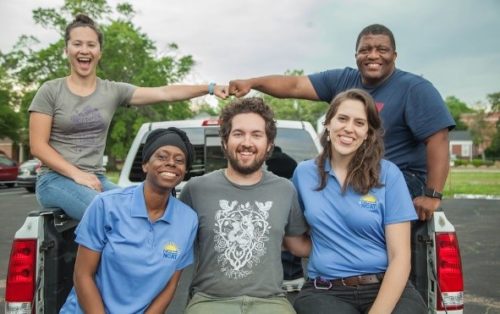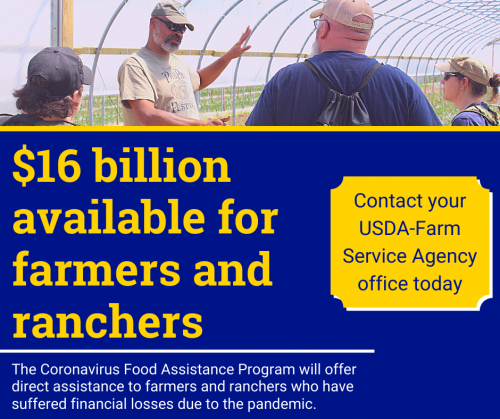By Luke Freeman, NCAT Horticulture Specialist
We are excited to announce that we have two new incubator farmers participating in the Woolsey Incubator Farm program in Fayetteville, AR! Their names are Lucy Capelle and Sandra Wesson, and they have both begun work on their quarter-acre farm plots.
We had a slow start to the season with disruptions from COVID-19 and Cobblestone Farms hiring a new farm manager. However, we have been able to onboard our new farmers in time for them to plant their fall-season crops.

Incubator farmer Lucy Capelle, at right, with friend Shailer Balton and their little farm helpers.
Lucy Capelle is a gardener who works in Northwest Arkansas’s Marshallese community to encourage health and wellness through gardening, good nutrition, and active lifestyles. She wants to develop her farm business to serve the Marshallese community. She hopes they can buy fresh fruits and vegetables from their own local farmers and revive traditional farming practices from the Marshall Islands.
Lucy grew up helping her father on their coconut, banana, and pumpkin plantations on the Marshall Islands. She helped plant and harvest their crops and also tended to the chickens and pigs they raised.
Lucy has already started her late-season summer crops and fall-season crops in the greenhouse. She will be growing corn, okra, squash, pumpkins, broccoli, cabbage, and fall root crops this year.
Sandra Wesson also has a background in gardening. She is interested in growing her skills to supply organic produce to local restaurants and farmers markets in Northwest Arkansas. She is from Central Arkansas, but recently moved to Fayetteville for work and to be close to her grandchild. In Central Arkansas she was close to market farmers Mary and Rickey Bone of Lighthouse Farms and was inspired by their successful farm business.

Incubator farmer Sandra Wesson preps her plot for fall crops.
Sandra is currently working on preparing her plot for planting, removing the plastic mulch and crop residues from last year.
Events this Fall
We have plans to host two more workshops at Cobblestone on organic vegetable production. We also plan to have project partners lead field trips to the farm this fall. However, our staff are monitoring the COVID-19 situation to determine the most responsible way to use the incubator farm as an educational resource. At this point we are considering the option of allowing farmers to participate in the workshops remotely through video, but we have yet to make the call.

Lucy’s farm plot, getting ready for planting.
Stay tuned on our Facebook page to find out when our workshops will take place and how you can participate.
Project Background and Overview
The Woolsey Incubator Farm Project is complex and ambitious. It wouldn’t be possible without our great partners and supportive community. Our mission is to educate K-12 students and adults of all ages in Northwest Arkansas about sustainable agriculture and environmental conservation. We want to demonstrate how local food systems affect the environment. We also want to highlight the role that sustainable agriculture can play in environmental stewardship. Following is a list of goals we hope to accomplish with the help of our partners.
- Train and support five incubator farmers as they start and grow their farm businesses.
- Train farmers and prospective farmers on sustainable agriculture practices. We’ll host a series of four practical skills trainings led by NCAT agriculture specialists at Cobblestone Farms.
- Educate members of the community on the environmental benefits of wetland prairie and native plants. Illinois River Watershed Partnership (IRWP) will lead a passive restoration of two acres of wetland prairie at the Woolsey Farm. IRWP will then lead a prairie walk at the property. They will also create and post signage on the property to educate the community about how wetland prairie and native plants affect the ecosystem.
- Educate primary-level students about local agriculture, environmental stewardship, and local food systems through field trips to Cobblestone Farms and the Woolsey Incubator Farm.
- Educate high school students through field trips to Cobblestone Farms and the Woolsey Incubator Farm.
Creating an incubator farm is key to accomplishing our goals. It will be the home base for our educational activities. We are working closely with the City of Fayetteville to prepare the city-owned historic Woolsey Farm site to house the incubator farm. Once it’s established, we expect the Woolsey Incubator Farm to educate hundreds of farmers, students, and adults for years to come. Cobblestone Farms generously provided plots for our first incubator farmers until the Woolsey Farm property is ready. For more on our activities for this project, see our previous blog post Incubator Farm Project Cultivates Farmers and Community.
More Information
Whether you’re a beginning farmer or have years of experience, check out the ATTRA Sustainable Agriculture website! There are hundreds of resources on sustainable agriculture topics, including publications, videos, online courses, webinars, podcasts, and more. And if you’d like an agriculture specialist to provide a one-on-one consultation, call 1-800-346-9140 or email your questions to askanag@ncat.org.





 You might be able to gain new customers during this time, as people are wanting to stock their freezers and prepare for supply-chain disruptions. You want to ensure that these new customers continue purchasing from you even after the grocery stores are restocked. In order to do this, you must provide an excellent product and good customer service. It is tempting to quickly scale up production to take advantage of the demand, but don’t do so at the cost of quality. Don’t process and sell animals that don’t meet your highest quality standards. Providing great customer service is another way to keep customers coming back. NCAT Specialist Dave Scott and his wife Jenny shared some really great tips on providing excellent customer service to their meat customers in the “Direct Marketing Meat” podcast series.
You might be able to gain new customers during this time, as people are wanting to stock their freezers and prepare for supply-chain disruptions. You want to ensure that these new customers continue purchasing from you even after the grocery stores are restocked. In order to do this, you must provide an excellent product and good customer service. It is tempting to quickly scale up production to take advantage of the demand, but don’t do so at the cost of quality. Don’t process and sell animals that don’t meet your highest quality standards. Providing great customer service is another way to keep customers coming back. NCAT Specialist Dave Scott and his wife Jenny shared some really great tips on providing excellent customer service to their meat customers in the “Direct Marketing Meat” podcast series. Another challenge many livestock producers are facing is the lack of processing. Access to meat processing facilities has always been a challenge for small-scale livestock producers. The problem has been exacerbated during the pandemic. Producers are increasing production in response to increased demand for direct-to-consumer meat sales—which means there are more animals to process in facilities that already have limited availability. For example, I can usually call just a couple of months in advance to schedule a processing date for our animals; I called our processor in May and the earliest dates they had were in January 2021! Our hog will be awfully big by then. If you are a livestock producer and haven’t already booked your processing appointments for the coming year, I encourage you to call your processor today. I had a great conversation with Rebecca Thistlethwaite with the
Another challenge many livestock producers are facing is the lack of processing. Access to meat processing facilities has always been a challenge for small-scale livestock producers. The problem has been exacerbated during the pandemic. Producers are increasing production in response to increased demand for direct-to-consumer meat sales—which means there are more animals to process in facilities that already have limited availability. For example, I can usually call just a couple of months in advance to schedule a processing date for our animals; I called our processor in May and the earliest dates they had were in January 2021! Our hog will be awfully big by then. If you are a livestock producer and haven’t already booked your processing appointments for the coming year, I encourage you to call your processor today. I had a great conversation with Rebecca Thistlethwaite with the 


